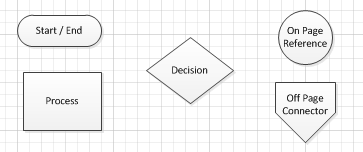Every Company Can Benefit from Flowcharts
Imagine a company that is running without documented processes in place. Even someone who is not an internal audit expert would think that would raise some red flags. What about companies that have outdated documented processes, or documentation with a sub-par level of detail? Shouldn’t that also raise red flags?
Why do we need documented processes?
- They allow others (e.g., management, auditors, new hires) to understand the process.
- They get everyone in agreement with how the process should be structured.
- They assign responsibilities to each person so they can be accountable for their tasks.
- They identify risks and controls throughout the process, or lack thereof.
- They facilitate the discussion for process improvements.
Making the case for flowcharts
Flowcharts are my preferred method of process documentation. After I conduct process discussion meetings, I like to skip the narrative write-up and use my meeting notes to create a flowchart. If you give someone a narrative to review, they tend to skim it—then they say it looks good, or offer minimal comments. If you put the same information into a flowchart, they are more likely to see areas for improvement or expansion.
I like to use flowcharts with swim lanes (see the example below) because each task is assigned to a person. If someone sees that tasks are assigned to them in a flowchart, they will want to make sure they are accurate. If risky areas are assigned to a certain person, they will want to remediate them. Controls are noted throughout the process as well, which allows the reader to get a better understanding of what happens before and after each control, and who performs each step.
I review narratives all the time, and I can easily make a list of process improvement suggestions. But when I take those same narratives and put them into a flowchart, there are so many more questions for me to ask because I can see the red flags so clearly. For example, I can see that there may be no review process for a certain step. Or, there may be segregation of duties issues or missing steps that are evident.
I once made a flowchart that had so many tiny boxes that every open space on the flowchart was filled. I was so proud of myself that I actually fit everything on one page. Yet when I gave it to my boss, he refused to read it. A flowchart should be a simple visual depiction of a process. If it is too complicated, it is not helpful. I subsequently separated that flowchart into sub-processes, and it was so much better. That started my love for flowcharting.
See below for flowcharting samples that use swim lanes to identify who is responsible for each task.
Creating flowcharts in seven steps
If a company already has process narratives, but they need to be revised, you can use them as a starting point to create flowcharts. I recommend the following seven steps to help guide your process:
- Review the current narratives and write notes and questions to discuss where obvious red flags exist.
- Conduct separate meetings for each sub-process. Use the old narrative and your notes for a guide, and discuss the process from start to finish. Ask questions throughout to make sure you capture the correct level of detail.
- Turn your meeting notes into flowcharts. (I use Microsoft Visio; see below for flowchart tips.)
- Have each person involved in the process review the flowcharts and provide notes for edits.
- Make the edits requested and resubmit the flowcharts for review until they are accurate.
- Provide a list of recommendations for stronger controls and best practices, along with the completed flowcharts, to the person requesting them and each person included in the process.
- Follow up on the remediation plans and incorporate any changes into the flowcharts for new, stronger controls.
If a company does not have any documentation for a process, start by determining what sub-processes you want to cover in the flowcharts. Conduct meetings with the people involved in each sub-process and ask them to describe what they do from start to finish. Refer to steps 3-7 above.
Flowcharting tips
- Make sure a person or department is identified for each step.
- Use titles, not names, so you don’t have to constantly update a flowchart for turnover. Also, it is more helpful to see if the job title matches up to the task. For example, if you show that Amy can approve a wire transfer, wouldn’t it be good to know if Amy should be approving a wire transfer? Is Amy the receptionist or is she the CFO?
- Each box should include one sentence or phrase. If more information is needed, add a note box underneath the flowchart.
- Always have a beginning and an end. You can connect one flowchart to another with an off-page connector instead of an end box.
- Make sure the arrows are going in the correct direction.
- Use the rows by person to identify any segregation of duties issues.
- If the flowchart is too crowded, break it up into multiple flowcharts.
- Each person mentioned in the flowchart should review it.
- Consider using common shapes:

Who can create flowcharts?
Process owners or internal audit staff can easily create flowcharts using Microsoft Visio. If you need outside help, Marcum can assist you. We have dedicated internal auditors that can conduct meetings with your process owners and convert their notes into flowcharts. We can provide a list of recommendations for stronger controls and best practices. We are also available for on-site training for your staff. Please also see our Excellent Audit Documentation blog for more information related to proper documentation.
Do you have questions about flowcharts or other accounting and auditing matters? Please contact your Marcum representative.




















